Hadassah Medical Center
| Hadassah Medical Center | |
|---|---|
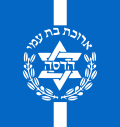 | |
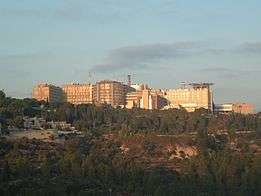 | |
| Geography | |
| Location | Jerusalem |
| Coordinates | Coordinates: 31°47′50″N 35°14′31″E / 31.79722°N 35.24194°E |
| Organisation | |
| Hospital type | Teaching |
| Affiliated university | Hebrew University of Jerusalem |
| Patron | Hadassah Women's Zionist Organization of America |
| Services | |
| Beds | 1,000 |
| History | |
| Founded | 1934 |
| Links | |
| Website | http://www.hadassah.org.il |
Hadassah Medical Center (Hebrew: מרכז רפואי הדסה) is a medical organization established in 1934 that operates two university hospitals at Ein Kerem and Mount Scopus in Jerusalem as well as schools of medicine, dentistry, nursing, and pharmacology affiliated with the Hebrew University of Jerusalem. Its declared mission is to extend a "hand to all, without regard for race, religion or ethnic origin."[1]
The hospital was founded by Hadassah, the Women's Zionist Organization of America, which continues to underwrite a large part of its budget today. The Medical Center ranks as the sixth-largest hospital complex in Israel.[2] Across its two campuses, Hadassah Medical Center has a total of 1,000 beds, 31 operating theaters and nine special intensive care units, and runs five schools of medical professions.[1]
History
Late Ottoman period (1912-1915)
The Hadassah organization was established in 1912 in New York City to provide health care in Ottoman-ruled Jerusalem.[3] In 1913, Hadassah sent two nurses to Palestine.[3] They set up a small public health station in Jerusalem to provide maternity care and treat trachoma, a dreaded eye disease rampant in the Middle East.[3] During the First World War the Ottoman authorities suspected Jews of sympathies with the enemy and in 1915 the Hadassah Nurses station had to closed down due to official pressure.[3]
Activities throughout Mandate Palestine (1918-1948)
In 1918, Hadassah established the American Zionist Medical Unit (AZMU), manned by 45 medical health professionals. The AZMU helped to establish six hospitals in Palestine which were then turned over to municipal authorities. The Meir Rothschild Hospital opened in Jerusalem in 1918.[4] That year, Hadassah also founded a nursing school to train local personnel and create a cadre of nurses.[3]
In 1919, Hadassah organized the first School Hygiene Department in Palestine to give routine health examinations to Jerusalem school children. During the Arab riots of 1920, Hadassah nurses cared for the wounded on both sides. Henrietta Szold moved to Jerusalem that year to develop community health and preventive care programs.[3]
In 1921, a Hadassah nurse, Bertha Landsman, set up the first Tipat Halav perinatal care center in Jerusalem, and Hadassah opened a hospital in Tel Aviv. The following year, it established a hospital in Haifa.[3] In 1926, Hadassah established the first tuberculosis treatment center in Safed. In 1929, Hadassah opened the Nathan and Lina Straus Health Center in Jerusalem. In the 1930s, planning began for a new hospital to replace the Rothschild hospital founded in 1888 on Street of the Prophets, Jerusalem. Rose Halprin, Hadassah's sixth national president, moved to Jerusalem to serve as liaison between the American office and Hadassah in Palestine. The Rothschild-Hadassah University Hospital, the first teaching hospital and medical center in Palestine, opened on May 9, 1939.[3]
The Hadassah Medical Organization operated an infirmary in Hebron.[5] The Beit Hadassah clinic had three floors with the infirmary, the pharmacy and the synagogue on the top floor.[6] Free care was provided to Jews and Arabs.[7] The building dates back to 1893 as was originally called the Chesed L'Avraham clinic.[8] In 1929 it was the site of some of the worst of the Hebron massacre.[9][10]
The British Royal Commission, known as the Peel Commission, praised the work of Hadassah in its 1937 report:
The Hadassah Medical Organization has developed a widespread system of clinics in Jewish centres and hospitals in the principal towns...Though naturally the Jewish population benefited most, the Hadassah medical services were available to all the communities in Palestine and many of the poorer classes amongst the Arabs received much assistance from the work of the organization. This disinterested philanthropy of Hadassah deserves recognition: it was a real step towards the promotion of good feeling between the two races; but unhappily the effect of its work was impaired by other influences.[11]
The Hadassah Hospital on Mount Scopus opened in 1939 and had to be closed down in 1948.
1948-1967
As a result of the 1948 war, Mount Scopus with the Hadassah Hospital were left as an Israeli exclave, guarded by a small number of Israeli armed personnel, and all the activities at the medical campus had to be abandoned. An alternative set of locations in West Jerusalem were adopted by the evacuated medical staff for continuing their activity. In 1961 a new medical complex was built in Ein Karem on the outskirts of Jerusalem.
After 1967
During the Six-Day War, Israel conquered the entire area around Mount Scopus and the old medical campus was eventually reactivated. Both campuses are currently active, with the Ein Karem facilities being by far the larger and more important of the two.
Since 2005
In 2005, Hadassah was nominated for the Nobel Peace Prize in acknowledgment of its equal treatment of all patients, regardless of ethnic and religious differences, and efforts to build bridges to peace.[12][13]
French baritone David Serero has performed several concerts at the Hospital in 2011, 2012 and 2013 for Israelis and Palestinians children. He is the young president of the organization in France.[14]
Due to an accumulated deficit of over 1 billion NIS, at the request of the medical center's management, the Israeli court declared 3 months of suspension of proceedings starting February 2014.[15]
Mount Scopus campus
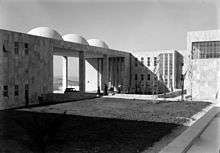
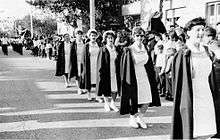
The cornerstone for the Hadassah hospital on Mount Scopus was laid in 1934. After five years of construction, the complex, designed by architect Erich Mendelsohn,[16] opened its doors in 1939.
In March 1947, the leader of the Arab Forces in Jerusalem, Abd al-Qadir al-Husayni, threatened to blow up the hospital. He did not do so, but attacks were carried out on traffic to and from the hospital. On April 13, 1948, an armoured convoy of doctors, nurses, medical students, and other staff made its way to the hospital. The group was ambushed, and 78 people were killed in what became known as the Hadassah medical convoy massacre.[17]
Under the 1949 armistice agreement with Jordan, Mount Scopus was declared a demilitarized enclave and operation of the hospital became impossible.[18] The staff moved to temporary quarters in Jerusalem and eventually a new campus was built in Ein Kerem.
During the occupation of East Jerusalem following the Six-Day War, Hadassah Mount Scopus underwent extensive renovations, reopening in 1975. With over 300 beds and 30 departments and clinics, the hospital serves all populations in Jerusalem without distinction.[19] Over one-third of the patients are Arab.[20] In 2011, the Israeli-American actress Natalie Portman, who was born at Hadassah Mount Scopus, starred in a fundraising campaign for the hospital.[21]
Ein Kerem campus
From 1948-1962, Hadassah hospital operated in rented quarters in five different locations in Jerusalem,[22] including what is now the Anglican International School on Street of the Prophets in Jerusalem. In 1961, a new medical complex was built in Ein Karem in southwest Jerusalem under the direction of then-director general Kalman Mann. The Hadassah Women's Zionist Organization of America again assisted with funding, and the somewhat out-of-the-way location was chosen in part because an appropriate site was difficult to obtain in the city-center, and Hadassah owned a large plot in Ein Kerem. The hospital was designed by Joseph Neufeld, a pioneer of International Style architecture in Israel.[23]
Prior to the opening of a 19-story hospital tower in 2012, Hadassah Ein Karem had 700 inpatient beds. The hospital complex consists of 22 buildings, including the Hebrew University of Jerusalem schools of medicine, dentistry, nursing, public health and pharmacology.
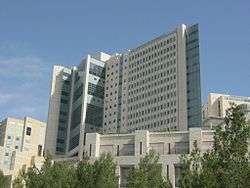
Hadassah's director is Professor Yuval Weiss. Notable physicians include Avraham Rivkind, founder and director of the hospital's trauma center, Ahmed Eid, head of the liver and kidney transplant unit, and Arie Eldad, head of the department of plastic surgery and burns unit.
In March 2007, Jewish American billionaire William Davidson donated $75 million to the hospital.[24] In 2012, the Sarah Wetsman Davidson Hospital Tower opened with 500 beds and 20 operating theaters.[23]
In 2008 Prime Minister John Key of New Zealand made a donation to the hospital.[25]
In April 2009, following an initiative of the Puah Institute, the hospital opened a fertility clinic for AIDS patients, the first such clinic in Israel. Prof. Shlomo Ma'ayan heads the clinic.[26][27]
Chagall windows
The Ein Karem campus synagogue is illuminated by stained glass windows depicting the twelve tribes of Israel, created by Marc Chagall. Chagall envisaged the synagogue as "a crown offered to the Jewish Queen," and the windows as "jewels of translucent fire. The windows were installed February 1962. At the dedication ceremony, Chagall said: "A stained glass window is a transparent partition between my heart and the heart of the world...To read the Bible is to perceive a certain light, and the window has to make this obvious through its simplicity and grace... The thoughts have nested in me for many years, since the time when my feet walked on the Holy Land, when I prepared myself to create engravings of the Bible. They strengthened me and encouraged me to bring my modest gift to the Jewish people, that people that lived here thousands of years ago.[28]
New entrance pavilion
In 2012, a new glassed-in entrance pavilion opened at the foot of the Davidson Tower which funnels all traffic entering the hospital. Alongside the building are four "healing gardens" planned by Shlomo Aronson employing the principles of biophilic design, which posits that nature and vegetation impact positively on human health.[23]
Notable alumni

- Arie S. Belldegrun (born 1949), director of the UCLA Institute of Urologic Oncology and is Professor and Chief of Urologic Oncology at the David Geffen School of Medicine[29][30]
- Rivka Carmi (born 1948), pediatrician, geneticist, President of Ben-Gurion University of the Negev
- Aaron Ciechanover (born 1947), biologist and Nobel laureate in Chemistry
- Avram Hershko (born 1937), Hungarian-born Israeli biochemist and Nobel laureate in Chemistry
- Emanuel Margoliash (1920–2008), biochemist
- Avraham Steinberg (born 1947) Professor of Medical Ethics, Director of Hadassah Medical Ethics Center, and Pediatric Neurologist
See also
References
- 1 2 Jack Khoury (2012-10-10). "Hadassah Hospital: Extending a 'Hand to All' - Hadassah at 100: Where No Man Has Gone Before". Haaretz.com. Retrieved 2016-02-10.
- ↑ Ayala Hurwicz (2007-05-07). "Sheba - Largest Hospital in Israel" (in Hebrew). Retrieved 2007-09-14.
- 1 2 3 4 5 6 7 8 "Hadassah". Zionism-israel.com. Retrieved 2016-02-10.
- ↑ "History". Hadassah-med.com. Retrieved 2016-02-10.
- ↑ "Hadassah Opens 21st Welfare Station in Palestine". Jewish Telegraphic Agency. 1929-04-10. Retrieved 2016-07-31.
The new infant welfare clinic is in Hebron...The Histadruth Nashim Ibriot (Hebrew Women’s Association) of Palestine will assist in the maintenance of the Hebron clinic by a monthly contribution.
- ↑ Sochen, June (Spring 2003). "Both the dove and the serpent: Hadassah's work in 1920s Palestine". 52 (1-2). New York: Judaism; a Journal of Jewish Life & Thought: 71–83.
- ↑ Auerbach, Jerold S. (2009). Hebron Jews memory and conflict in the land of Israel. Lanham, Md.: Rowman & Littlefield. p. 60. ISBN 9780742566170.
- ↑ "Beit Hadassah -". the Jewish Community of Hebron. Retrieved 2016-07-31.
- ↑ "Hebron, Five Weeks After the Massacre". Jewish Telegraphic Agency. 1929-10-09. Retrieved 2016-07-31.
But the practical commission could not help seeing things such as the wrecked and charred Hadassah clinic, which for more than a decade cured... who turned around and destroyed the premises, pillaged the medicants which had saved them from decimation by loathsome diseases;
- ↑ "Fourth Day of Palestine Warfare Finds Jewry in Grave Danger Throughout Country". Jewish Telegraphic Agency. 1929-08-27. Retrieved 2016-07-31.
The dispensary of the Hadassah Hospital at Hebron, maintained by the American Women’s Zionist Organization, was burned.
- ↑ Peel Commission report, July 1937, chapter 12, page 312 (paragraph 5)
- ↑ Sheffer, Doron (2005-03-20). "Local hospitals up for Nobel Prize". Ynet. Retrieved 2007-09-15.
- ↑
- ↑ "IsraelValley News: Le chanteur d'opéra français David Serero se produira au CHU Hadassah". Israelvalley.com. Retrieved 2016-02-10.
- ↑ SPENCER, Ho (2014-03-14). "Court stays proceedings, appoints trustees for Hadassah". Times of Israel. Retrieved 2014-05-10.
- ↑ "Reviews - Mendelsohn'S Incessant Visions". Architectmovie.weebly.com. 2011-07-07. Retrieved 2016-02-10.
- ↑ Archived March 28, 2015, at the Wayback Machine.
- ↑ "To Be a Doctor in Jerusalem: Life under Threat of Terrorism | Annals of Internal Medicine". Annals.org. Retrieved 2016-02-10.
- ↑ Archived August 1, 2014, at the Wayback Machine.
- ↑ Siegel, Judy (2011-07-13). "'Hadassah Mount Scopus sees regular violence' - Health & Science - Jerusalem Post". Jpost.com. Retrieved 2016-02-10.
- ↑ "Natalie Portman promotes Hadassah - Israel Activism, Ynetnews". Ynetnews.com. 1995-06-20. Retrieved 2016-02-10.
- ↑ Archived November 2, 2014, at the Wayback Machine.
- 1 2 3 Dvir, Noam. "Article Iphone View Element". Haaretz.com. Retrieved 2016-02-10.
- ↑ "American Jewish businessman donates $75 million to Jerusalem hospital". Ynet. 2007-04-03. Retrieved 2007-09-15.
- ↑ Gay, Edward (November 10, 2008). "World media: NZ election vote 'as reasoned as a doped slug'". The New Zealand Herald. Retrieved October 2, 2011.
- ↑ "HIV Fertility Clinic Opens In Jerusalem, Israel - Viral Disease Carriers Can Have Disease-free Children". Medical News Today. Retrieved 2016-02-10.
- ↑ Yedioth Aharonot, Feb 23, 2009 "Fertility Clinic for AIDS carriers", Nissan Straucher and Dani Adino-Abba
- ↑ Chagall, Marc. Marc Chagall on Art and Culture, editor: Benjamin Harshav. Stanford Univ. Press (2003)
- ↑ "Arie Belldegrun M.D. | David Geffen School of Medicine at UCLA". People.healthsciences.ucla.edu. Retrieved 2016-02-10.
- ↑ "Arie Belldegrun, M.D". Usrf.org. Retrieved 2016-02-10.
Further reading
- Levin, Marlin (2002). It Takes a Dream: The story of Hadassah. Gefen Publishing House Ltd. ISBN 9652293008.
External links
- Guide to the Hadassah Archives on Long-term Deposit at the American Jewish Historical Society at the Center for Jewish History
- Guide to the Hadassah Medical Organization Records in the Hadassah Archives, 1918-2011 on Long-term Deposit at the American Jewish Historical Society at the Center for Jewish History
- Guide to the Architectural Records in the Hadassah Archives on Long-term Deposit at the American Jewish Historical Society at the Center for Jewish History
- Hadassah Medical Center
- ↑ "Hadassah Opens 21st Welfare Station in Palestine". Jewish Telegraphic Agency. 1929-04-10. Retrieved 2016-07-31.